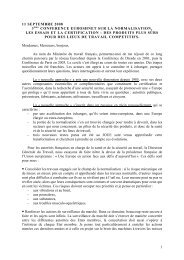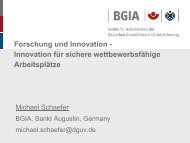Guide to the implementation of directives based on the New ...
Guide to the implementation of directives based on the New ...
Guide to the implementation of directives based on the New ...
You also want an ePaper? Increase the reach of your titles
YUMPU automatically turns print PDFs into web optimized ePapers that Google loves.
❝ <str<strong>on</strong>g>Guide</str<strong>on</strong>g> <str<strong>on</strong>g>to</str<strong>on</strong>g> <str<strong>on</strong>g>the</str<strong>on</strong>g> <str<strong>on</strong>g>implementati<strong>on</strong></str<strong>on</strong>g> <str<strong>on</strong>g>of</str<strong>on</strong>g> <str<strong>on</strong>g>directives</str<strong>on</strong>g> <str<strong>on</strong>g>based</str<strong>on</strong>g> <strong>on</strong> <str<strong>on</strong>g>the</str<strong>on</strong>g> <strong>New</strong> Approach and <str<strong>on</strong>g>the</str<strong>on</strong>g> Global Approach ❞<br />
( 4 ) The <strong>New</strong> Approach<br />
has not been applied in<br />
sec<str<strong>on</strong>g>to</str<strong>on</strong>g>rs where<br />
Community legislati<strong>on</strong><br />
was well advanced<br />
prior <str<strong>on</strong>g>to</str<strong>on</strong>g> 1985, or where<br />
provisi<strong>on</strong>s for finished<br />
products and hazards<br />
related <str<strong>on</strong>g>to</str<strong>on</strong>g> such<br />
products cannot be<br />
laid down. For instance,<br />
Community legislati<strong>on</strong><br />
<strong>on</strong> foodstuffs, chemical<br />
products,<br />
pharmaceutical<br />
products, mo<str<strong>on</strong>g>to</str<strong>on</strong>g>r<br />
vehicles and trac<str<strong>on</strong>g>to</str<strong>on</strong>g>rs<br />
does not follow <str<strong>on</strong>g>the</str<strong>on</strong>g><br />
principles <str<strong>on</strong>g>of</str<strong>on</strong>g> <str<strong>on</strong>g>the</str<strong>on</strong>g> <strong>New</strong><br />
Approach.<br />
( 5 ) Third party approval<br />
<str<strong>on</strong>g>of</str<strong>on</strong>g> product or<br />
producti<strong>on</strong> quality<br />
assurance systems and<br />
third party product<br />
verificati<strong>on</strong> can also be<br />
provided for without<br />
third party type or<br />
design examinati<strong>on</strong>.<br />
( 6 ) The standard<br />
elements are<br />
presented in <str<strong>on</strong>g>the</str<strong>on</strong>g> order<br />
usually followed in <str<strong>on</strong>g>the</str<strong>on</strong>g><br />
<strong>New</strong> Approach<br />
<str<strong>on</strong>g>directives</str<strong>on</strong>g>.<br />
Since <str<strong>on</strong>g>the</str<strong>on</strong>g> <strong>New</strong> Approach calls for essential requirements<br />
<str<strong>on</strong>g>to</str<strong>on</strong>g> be harm<strong>on</strong>ised and made manda<str<strong>on</strong>g>to</str<strong>on</strong>g>ry by <str<strong>on</strong>g>directives</str<strong>on</strong>g>,<br />
this approach is appropriate <strong>on</strong>ly where it is genuinely<br />
possible <str<strong>on</strong>g>to</str<strong>on</strong>g> distinguish between essential requirements<br />
and technical specificati<strong>on</strong>s. Fur<str<strong>on</strong>g>the</str<strong>on</strong>g>r, a wide range <str<strong>on</strong>g>of</str<strong>on</strong>g> products<br />
has <str<strong>on</strong>g>to</str<strong>on</strong>g> be sufficiently homogenous, or a horiz<strong>on</strong>tal<br />
hazard identifiable, <str<strong>on</strong>g>to</str<strong>on</strong>g> allow comm<strong>on</strong> essential requirements.<br />
The product area or hazard c<strong>on</strong>cerned must also be<br />
suitable for standardisati<strong>on</strong> ( 4 ).<br />
In additi<strong>on</strong> <str<strong>on</strong>g>to</str<strong>on</strong>g> <str<strong>on</strong>g>the</str<strong>on</strong>g> principles <str<strong>on</strong>g>of</str<strong>on</strong>g> <str<strong>on</strong>g>the</str<strong>on</strong>g> <strong>New</strong> Approach, c<strong>on</strong>diti<strong>on</strong>s<br />
for reliable c<strong>on</strong>formity assessment are necessary.<br />
The key elements in this respect are <str<strong>on</strong>g>the</str<strong>on</strong>g> building <str<strong>on</strong>g>of</str<strong>on</strong>g> c<strong>on</strong>fidence<br />
through competence and transparency, and <str<strong>on</strong>g>the</str<strong>on</strong>g><br />
setting up <str<strong>on</strong>g>of</str<strong>on</strong>g> a comprehensive policy and framework for<br />
c<strong>on</strong>formity assessment. The Council Resoluti<strong>on</strong> <str<strong>on</strong>g>of</str<strong>on</strong>g> 1989<br />
<strong>on</strong> <str<strong>on</strong>g>the</str<strong>on</strong>g> Global Approach <str<strong>on</strong>g>to</str<strong>on</strong>g> certificati<strong>on</strong> and testing states<br />
<str<strong>on</strong>g>the</str<strong>on</strong>g> following guiding principles for Community policy <strong>on</strong><br />
c<strong>on</strong>formity assessment.<br />
* A c<strong>on</strong>sistent approach is developed in Community legislati<strong>on</strong><br />
by devising modules for <str<strong>on</strong>g>the</str<strong>on</strong>g> various phases <str<strong>on</strong>g>of</str<strong>on</strong>g> c<strong>on</strong>formity<br />
assessment procedures, and by laying down criteria<br />
for <str<strong>on</strong>g>the</str<strong>on</strong>g> use <str<strong>on</strong>g>of</str<strong>on</strong>g> <str<strong>on</strong>g>the</str<strong>on</strong>g>se procedures, for <str<strong>on</strong>g>the</str<strong>on</strong>g> designati<strong>on</strong> <str<strong>on</strong>g>of</str<strong>on</strong>g> bodies<br />
operating <str<strong>on</strong>g>the</str<strong>on</strong>g>se procedures, and for <str<strong>on</strong>g>the</str<strong>on</strong>g> use <str<strong>on</strong>g>of</str<strong>on</strong>g> <str<strong>on</strong>g>the</str<strong>on</strong>g> CE<br />
marking.<br />
* The use <str<strong>on</strong>g>of</str<strong>on</strong>g> European standards relating <str<strong>on</strong>g>to</str<strong>on</strong>g> quality assurance<br />
(EN ISO 9000 series), and <str<strong>on</strong>g>to</str<strong>on</strong>g> <str<strong>on</strong>g>the</str<strong>on</strong>g> requirements <str<strong>on</strong>g>to</str<strong>on</strong>g> be<br />
fulfilled by c<strong>on</strong>formity assessment bodies operating quality<br />
assurance (EN 45000 series) is generalised.<br />
* Setting up <str<strong>on</strong>g>of</str<strong>on</strong>g> accreditati<strong>on</strong> systems and<br />
<str<strong>on</strong>g>the</str<strong>on</strong>g> use <str<strong>on</strong>g>of</str<strong>on</strong>g> inter-comparis<strong>on</strong> techniques<br />
are promoted in Member States and at<br />
Community level.<br />
* Mutual recogniti<strong>on</strong> agreements c<strong>on</strong>cerning<br />
testing and certificati<strong>on</strong> in <str<strong>on</strong>g>the</str<strong>on</strong>g> n<strong>on</strong>regula<str<strong>on</strong>g>to</str<strong>on</strong>g>ry<br />
sphere are promoted.<br />
* The differences <str<strong>on</strong>g>of</str<strong>on</strong>g> existing quality infrastructures<br />
(such as calibrati<strong>on</strong> and metrology<br />
systems, testing labora<str<strong>on</strong>g>to</str<strong>on</strong>g>ries, certificati<strong>on</strong><br />
and inspecti<strong>on</strong> bodies, and accreditati<strong>on</strong><br />
bodies) between Member States and<br />
between industrial sec<str<strong>on</strong>g>to</str<strong>on</strong>g>rs are minimised by<br />
programmes.<br />
* Internati<strong>on</strong>al trade between <str<strong>on</strong>g>the</str<strong>on</strong>g> Community<br />
and third countries is promoted by<br />
means <str<strong>on</strong>g>of</str<strong>on</strong>g> mutual recogniti<strong>on</strong> agreements,<br />
cooperati<strong>on</strong> and technical assistance programmes.<br />
The <strong>New</strong> Approach entailed refining c<strong>on</strong>formity<br />
assessment in such a way as <str<strong>on</strong>g>to</str<strong>on</strong>g><br />
allow <str<strong>on</strong>g>the</str<strong>on</strong>g> Community legisla<str<strong>on</strong>g>to</str<strong>on</strong>g>r <str<strong>on</strong>g>to</str<strong>on</strong>g> evaluate<br />
<str<strong>on</strong>g>the</str<strong>on</strong>g> c<strong>on</strong>sequences <str<strong>on</strong>g>of</str<strong>on</strong>g> <str<strong>on</strong>g>the</str<strong>on</strong>g> utilisati<strong>on</strong> <str<strong>on</strong>g>of</str<strong>on</strong>g> different<br />
c<strong>on</strong>formity assessment mechanisms.<br />
The objective was <str<strong>on</strong>g>to</str<strong>on</strong>g> provide flexibility <str<strong>on</strong>g>of</str<strong>on</strong>g> c<strong>on</strong>formity<br />
assessment over <str<strong>on</strong>g>the</str<strong>on</strong>g> entire manufacturing process in order<br />
for it <str<strong>on</strong>g>to</str<strong>on</strong>g> be adapted <str<strong>on</strong>g>to</str<strong>on</strong>g> <str<strong>on</strong>g>the</str<strong>on</strong>g> needs <str<strong>on</strong>g>of</str<strong>on</strong>g> each individual operati<strong>on</strong>.<br />
The Global Approach introduced a modular approach,<br />
which subdivided c<strong>on</strong>formity assessment in<str<strong>on</strong>g>to</str<strong>on</strong>g> a number <str<strong>on</strong>g>of</str<strong>on</strong>g><br />
operati<strong>on</strong>s (modules). These modules differ according <str<strong>on</strong>g>to</str<strong>on</strong>g><br />
<str<strong>on</strong>g>the</str<strong>on</strong>g> stage <str<strong>on</strong>g>of</str<strong>on</strong>g> development <str<strong>on</strong>g>of</str<strong>on</strong>g> <str<strong>on</strong>g>the</str<strong>on</strong>g> product (for example<br />
design, pro<str<strong>on</strong>g>to</str<strong>on</strong>g>type, full producti<strong>on</strong>), <str<strong>on</strong>g>the</str<strong>on</strong>g> type <str<strong>on</strong>g>of</str<strong>on</strong>g> assessment<br />
involved (for example documentary checks, type approval,<br />
quality assurance), and <str<strong>on</strong>g>the</str<strong>on</strong>g> pers<strong>on</strong> carrying out <str<strong>on</strong>g>the</str<strong>on</strong>g> assessment<br />
(<str<strong>on</strong>g>the</str<strong>on</strong>g> manufacturer or a third party).<br />
The Global Approach was completed by Council Decisi<strong>on</strong><br />
90/683/EEC, which was replaced and brought up <str<strong>on</strong>g>to</str<strong>on</strong>g><br />
date by Decisi<strong>on</strong> 93/465/EEC. These decisi<strong>on</strong>s lay down<br />
general guidelines and detailed procedures for c<strong>on</strong>formity<br />
assessment that are <str<strong>on</strong>g>to</str<strong>on</strong>g> be used in <strong>New</strong> Approach <str<strong>on</strong>g>directives</str<strong>on</strong>g>.<br />
Thus, c<strong>on</strong>formity assessment is <str<strong>on</strong>g>based</str<strong>on</strong>g> <strong>on</strong>:<br />
● manufacturers’ internal design and producti<strong>on</strong> c<strong>on</strong>trol<br />
activities;<br />
● third party type examinati<strong>on</strong> combined with manufacturers’<br />
internal producti<strong>on</strong> c<strong>on</strong>trol activities;<br />
● third party type or design examinati<strong>on</strong> combined with<br />
third party approval <str<strong>on</strong>g>of</str<strong>on</strong>g> product or producti<strong>on</strong> quality assurance<br />
systems, or third party product verificati<strong>on</strong> ( 5 );<br />
● third party unit verificati<strong>on</strong> <str<strong>on</strong>g>of</str<strong>on</strong>g> design and producti<strong>on</strong>; or<br />
● third party approval <str<strong>on</strong>g>of</str<strong>on</strong>g> full quality assurance systems.<br />
In additi<strong>on</strong> <str<strong>on</strong>g>to</str<strong>on</strong>g> laying down guidelines for <str<strong>on</strong>g>the</str<strong>on</strong>g> use <str<strong>on</strong>g>of</str<strong>on</strong>g> c<strong>on</strong>formity<br />
assessment procedures in technical harm<strong>on</strong>isati<strong>on</strong><br />
<str<strong>on</strong>g>directives</str<strong>on</strong>g>, Decisi<strong>on</strong> 93/465/EEC harm<strong>on</strong>ises <str<strong>on</strong>g>the</str<strong>on</strong>g> rules for<br />
<str<strong>on</strong>g>the</str<strong>on</strong>g> affixing and use <str<strong>on</strong>g>of</str<strong>on</strong>g> <str<strong>on</strong>g>the</str<strong>on</strong>g> CE marking.<br />
1.2. Standard elements <str<strong>on</strong>g>of</str<strong>on</strong>g> <strong>New</strong> Approach<br />
<str<strong>on</strong>g>directives</str<strong>on</strong>g> ( 6 )<br />
● <strong>New</strong> Approach <str<strong>on</strong>g>directives</str<strong>on</strong>g> are <str<strong>on</strong>g>based</str<strong>on</strong>g> <strong>on</strong> <str<strong>on</strong>g>the</str<strong>on</strong>g> following<br />
principles.<br />
* Harm<strong>on</strong>isati<strong>on</strong> is limited <str<strong>on</strong>g>to</str<strong>on</strong>g> essential requirements.<br />
* Only products fulfilling <str<strong>on</strong>g>the</str<strong>on</strong>g> essential requirements may be<br />
placed <strong>on</strong> <str<strong>on</strong>g>the</str<strong>on</strong>g> market and put in<str<strong>on</strong>g>to</str<strong>on</strong>g> service.<br />
* Harm<strong>on</strong>ised standards, <str<strong>on</strong>g>the</str<strong>on</strong>g> reference numbers <str<strong>on</strong>g>of</str<strong>on</strong>g> which<br />
have been published in <str<strong>on</strong>g>the</str<strong>on</strong>g> Official Journal and which have<br />
been transposed in<str<strong>on</strong>g>to</str<strong>on</strong>g> nati<strong>on</strong>al standards, are presumed <str<strong>on</strong>g>to</str<strong>on</strong>g> c<strong>on</strong>form<br />
<str<strong>on</strong>g>to</str<strong>on</strong>g> <str<strong>on</strong>g>the</str<strong>on</strong>g> corresp<strong>on</strong>ding essential requirements.<br />
* Applicati<strong>on</strong> <str<strong>on</strong>g>of</str<strong>on</strong>g> harm<strong>on</strong>ised standards or o<str<strong>on</strong>g>the</str<strong>on</strong>g>r technical<br />
specificati<strong>on</strong>s remains voluntary, and manufacturers are free<br />
<str<strong>on</strong>g>to</str<strong>on</strong>g> choose any technical soluti<strong>on</strong> that provides compliance<br />
with <str<strong>on</strong>g>the</str<strong>on</strong>g> essential requirements.<br />
* Manufacturers may choose between different c<strong>on</strong>formity<br />
assessment procedures provided for in <str<strong>on</strong>g>the</str<strong>on</strong>g> applicable directive.<br />
Scope<br />
The scope defines <str<strong>on</strong>g>the</str<strong>on</strong>g> range <str<strong>on</strong>g>of</str<strong>on</strong>g> products covered by <str<strong>on</strong>g>the</str<strong>on</strong>g><br />
directive, or <str<strong>on</strong>g>the</str<strong>on</strong>g> nature <str<strong>on</strong>g>of</str<strong>on</strong>g> hazards <str<strong>on</strong>g>the</str<strong>on</strong>g> directive is intended<br />
8




